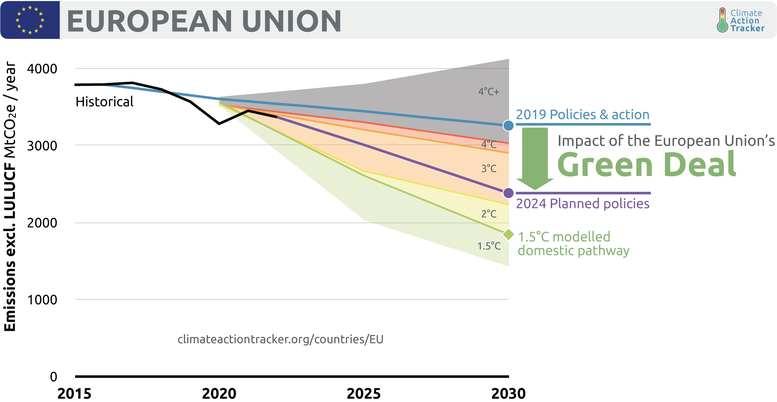EU's Green Deal improved its climate performance: a 1.5°C pathway is close
Now the EU needs to keep up the momentum, go the extra step and not roll back
Since the 2019 EU elections, the EU has significantly improved its climate performance through its implementation of the Green Deal. The EU’s emissions are now on a path consistent with scenarios that limit global temperature increase to a little above 2°C, a more than 1˚C improvement on the emissions pathway we estimated in 2019 before the elections and before the Green Deal.
While EU emissions are still not on a path compatible with the Paris Agreement's 1.5°C limit, this region, one of the world's largest greenhouse gas emitters, is in a good place to now go the extra step necessary to help the world avoid the worst impacts of climate change.
EU voters have a clear choice in the upcoming elections as to whether they want this strong action to continue.
The Climate Action Tracker continuously monitors the climate action of major emitters. Here, we compare our assessment of future greenhouse gas emissions made before the last EU elections in 2019 (i.e. before the Green Deal was implemented), and those of today.
We find that the newly implemented and planned policies under the EU's Green Deal have substantially improved the outlook of the EU’s greenhouse gas emissions. While in 2019 we estimated that EU policies would reduce emissions by 33% from 1990 levels, we now estimate emissions reduction of around 51% (see figure below), close to but short of its 55% by 2030 target.

The currently implemented and planned policies under the EU Green Deal lead to a path roughly aligned with global pathways that result in a little above a 2°C global temperature increase by the end of the century if other countries follow a similar level of ambition. This trajectory is more than a degree better than before the Green Deal, the level of action is now much higher than five years ago.
For this analysis, we compare our estimates of future emissions to modelled domestic pathways that represent the minimum required domestic emission reductions if accompanied with significant international climate finance. To be 1.5C aligned and to provide its full fair share to implementing the Paris Agreement the EU would need to adopt a domestic 2030 reduction target of at least 62% and significantly increase its international climate finance.
The significant difference in 2030 emissions from our 2019 estimate is due to policies that are part of the Green Deal, in particular:
- the additional measures for renewable energy,
- the reform of the EU’s emissions trading system,
- new standards for cars including only allowing sales of 100% emission-free cars by 2035,
- measures on energy efficiency and
- introduction of a second emissions trading system for transport and buildings.
The EU has made significant progress on climate policy in this closing election cycle. Europeans have the choice in the upcoming elections in early June 2024, to continue this success.
Stay informed
Subscribe to our newsletter